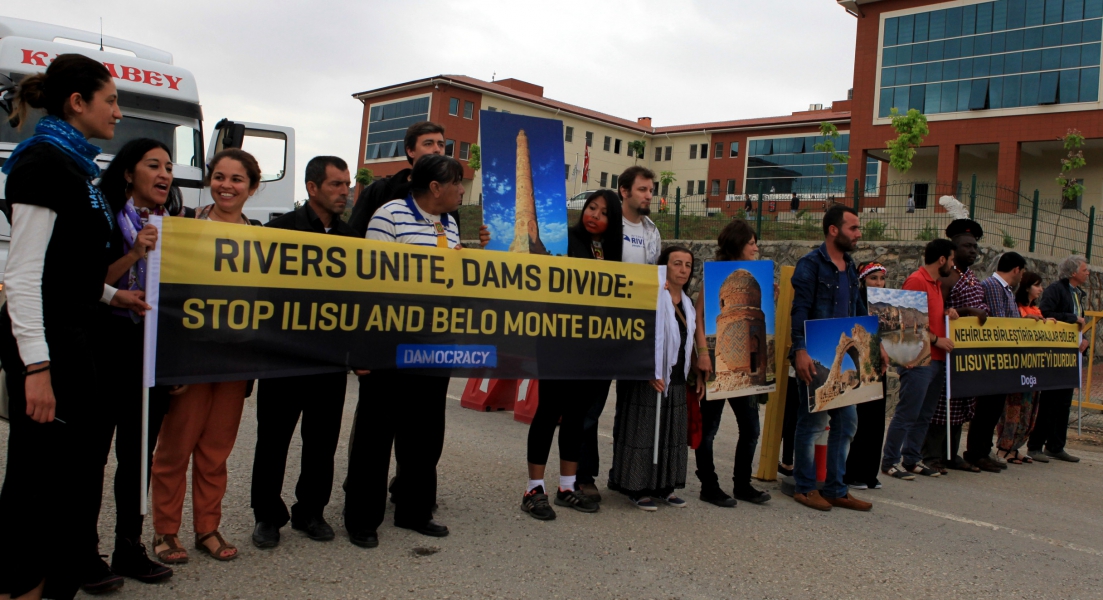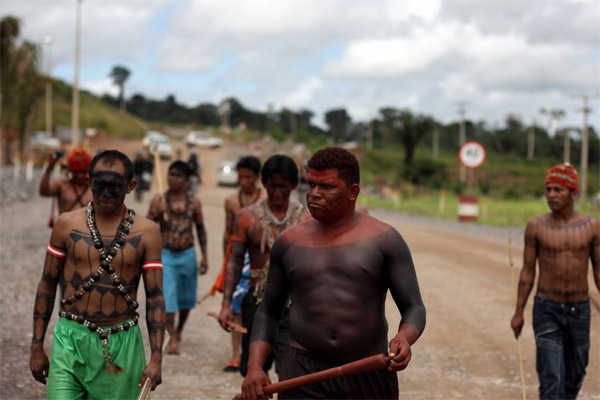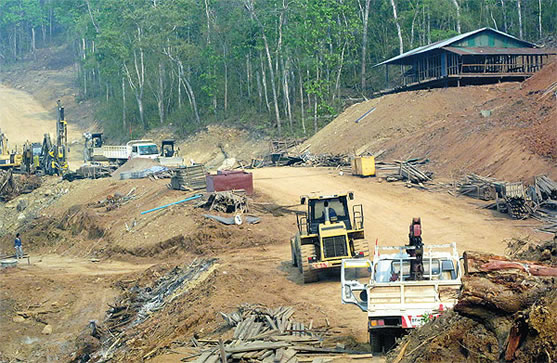
by Deep Green Resistance News Service | May 28, 2013 | Obstruction & Occupation
By Amazon Watch
Today [May 21, 2013] representatives of dam-affected communities and organizations from South America, the Middle East, Europe, the US and Africa, including Brazilian indigenous leaders accompanied by Amazon Watch, blocked the entrance to the construction site of the Ilisu dam in southeast Turkey demanding an end to controversial development that would sink an ancient city dating back to the Bronze Age.
Some 20 people including Kayapó Chief Megaron Txucarramae, one of Brazil’s most noted indigenous leaders in the struggle against the Belo Monte dam in the Amazon, held up banners in English and Turkish reading ‘Rivers Unite, Dams Divide: Stop Ilisu and Belo Monte dams.’ Delegates from the International Rivers Conference held in Istanbul last Saturday joined local protestors to show solidarity with their struggle to stop the Ilisu dam on the Tigris River, Turkey’s last free-flowing river.
“The peace process cannot be completed without the cancellation of the controversial Ilisu dam project and the protection of Hasankeyf. At the same time, damming the Tigris and Euphrates rivers and stopping their flow reaching Syria and Iraq is a contradiction to Turkey’s ‘zero problems’ policy with its neighbors because the increasing water crisis in the Mesopotamian basin may lead to increased conflict,” said Dicle Tuba Kilic, Rivers Program Coordinator for Doga (BirdLife Turkey).
The Belo Monte dam in Brazil and the Ilisu dam in Turkey are two of the most controversial mega-dam projects in the world today. Both dams are located in cultural and natural hotspots, inflicting devastating consequences and displacing over 75,000 people in Amazonia and Mesopotamia. In addition, the Ilisu dam, located a few kilometers from the Iraqi border, will affect the livelihood of Marsh Arabs living in the newly restored Basra Marshes. Turkey controls the Tigris and Euphrates headwaters, which dictates how much water flows downstream into Syria and Iraq.
“Our struggle to preserve the Xingu River from the Belo Monte dam is no different from the fight to protect the Tigris River from the Ilisu dam. We are unified in our positions to say ‘no’ to our governments. You cannot kill a river that sustains its people and culture,” said Kayapó Chief Megaron Txucarramae.
Legal and political controversies have surrounded the push to build the Belo Monte and Ilisu dams. No adequate Environmental Impact Assessment has been carried out for either dam, and both governments have failed to implement prior consultations and mitigation plans to protect the environment and rights of affected communities. Both dams proceed despite court rulings halting their construction and widespread national and international opposition to their development.
Faced by governments steamrolling human rights and environmental protections, dam-affected communities are uniting their struggle under the DAMOCRACY banner. DAMOCRACY includes 15 national and international organizations from all corners of the globe. Among them are Doga Dernegi, Amazon Watch, International Rivers, and RiverWatch.
Damocracy is produced by Doga Dernegi (BirdLife Turkey), in collaboration with other founding members of the Damocracy movement: Amazon Watch, International Rivers, RiverWatch, Gota D’água (Drop of Water) Movement, Instituto Socioambiental (ISA) and Movimento Xingu Vivo para Sempre (MXVPS).
To watch the documentary, visit: http;//www.youtube.com/DamocracyTV
From Amazon Watch: http://amazonwatch.org/news/2013/0521-international-activists-block-ilisu-dam-construction-site-in-turkey

by Deep Green Resistance News Service | May 5, 2013 | Biodiversity & Habitat Destruction, Colonialism & Conquest, Indigenous Autonomy, Obstruction & Occupation
By Mongabay
On Thursday roughly 200 indigenous people launched an occupation of a key construction site for the controversial Belo Monte dam in the Brazilian Amazon. The protestors, who represent communities that will be affected by the massive dam, are demanding immediate suspension of all work on hydroelectric projects on the Xingu, Tapajós and Teles Pires rivers until they are properly consulted, according to a coalition of environmental groups opposing the projects.
The protestors include members of the Juruna, Kayapó, Xipaya, Kuruaya, Asurini, Parakanã, Arara, and Munduruku tribes. Non-indigenous fishermen and riverine community members that will also be affected by Belo Monte have also reportedly joined the demonstration. Organizers say the occupation will continue “indefinitely or until the federal government meets their demands.”
“Today’s protest demonstrates the relentless resistance of a growing group of united peoples against Belo Monte, Tapajós and destructive dams throughout the Amazon,” said Leila Salazar-Lopez, Amazon Watch Program Director, in a statement. “These are the final moments to change course as construction closes in on the Xingu and other lifeline rivers of the Amazon.”
Belo Monte has been the site of several protests since the Brazilian government finalized approval of Belo Monte. Indigenous groups, local fishermen, and environmentalists are strongly opposed to the project, while will divert nearly 80 percent of the flow of the Xingu river, one of the Amazon’s mightiest tributaries. The dam will flood tens of thousands of hectares of land, displace more than 15,000 people, and could push several endemic fish species to extinction. Belo Monte, which will operate at less than 40 percent of capacity despite its $15 billion dollar price tag, will require additional upstream dams to be commercially viable, according to independent analysts, potentially amplifying the project’s impact.
Belo Monte and other dams on the Xingu represent just a small fraction of the hydropower projects being developed by Brazil in the Amazon Basin. According to an analysis published last year, 231 dams are currently planned in the Brazilian Amazon alone. Another 15 are slated for Peru and Bolivia.
Ecologists say there are myriad problems with large dams in tropical ecosystems, especially when built on the scale envisioned in the Amazon. Large dams interfere with the hydrological cycle and nutrient flows through an ecosystem, while restricting or blocking access to breeding and feeding grounds for migratory fish species. Meanwhile areas inundated with water can generate substantial greenhouse gas emissions. Design flaws in some tropical dams, which draw methane from the base of their reservoirs, can exacerbate climate impacts. Finally flooding in the reservoir area can displace communities traditionally dependent on rivers, while creating hardship downstream from degraded fisheries.
From Mongabay: “Tribesmen launch ‘occupy’ protest at dam site in the Amazon rainforest“
by Deep Green Resistance News Service | Mar 29, 2013 | Biodiversity & Habitat Destruction
By Emily Ford / The Times
About 28,000 rivers have disappeared from China’s state maps, an absence seized upon by environmentalists as evidence of the irreversible natural cost of developmental excesses.
More than half of the rivers previously thought to exist in China now appear to be missing, according to the 800,000 surveyors who compiled the first national water census, leaving Beijing fumbling to explain the cause.
Only 22,909 rivers, covering an area of 100 square kilometres were located by surveyors, compared with the more than 50,000 present in the 1990s, a three-year study by the Ministry of Water Resources and the National Bureau of Statistics found.
Officials blame the apparent loss on climate change, arguing that it has caused waterways to vanish, and on mistakes by earlier cartographers. But environmental experts say that the disappearance of the rivers is a real and a direct manifestation of headlong, ill-conceived development, where projects are often imposed or approved without public consultation.
The United Nations considers China one of the 13 countries most affected by water scarcity, as industrial toxins have poisoned historic water sources and were blamed last year for causing the Yangtze to turn an alarming shade of red. This month the carcasses of about 16,000 dead pigs dumped in the river have been pulled from its waters, and 1,000 dead ducks were found dumped this week in the Nanhe River in the southwestern Sichuan province.
Ma Jun, a water expert at the Institute of Public and Environmental Affairs, said that the missing rivers were a cause for “great attention” and underscored the urgent need for a more sustainable mode of development.
“There might be some disparity [in the number of rivers] due to different research methods. However, the disappearance of rivers is the reality. It is really happening in China because of the over-exploitation of river resources,” Mr Ma said. “One of the major reasons is the over-exploitation of the underground water reserves, while environmental destruction is another reason, because desertification of forests has caused a rain shortage in the mountain areas.”
Large hydroelectric projects such as the Three Gorges Dam, which diverted trillions of gallons of water to drier regions, were likely to have played a role, Mr Ma said.
The census charted a decline in water quality, citing the “severe over-exploitation” of underground water reserves by 60 of its biggest cities.
The report came as Li Keqiang, the new premier, gave a speech in which he pledged greater transparency on pollution, which Beijing fears is a potential catalyst for social unrest.
“We must take the steps in advance, rather than hurry to handle these issues when they have caused a disturbance in society,” Mr Li was quoted by state media as saying.
The missing rivers provoked wistful recollections among Chinese internet users, most of whom will have witnessed dizzying urbanisation.
“The rivers I used to play around have disappeared, the only ones left are polluted, we can’t eat the fish in them, they are all bitter,” a person using the name Pippi Shuanger wrote on Weibo, the Chinese version of Twitter.
Despite water shortages, the threat of floods is a problem for much of the Chinese mainland, with two thirds of the population living in flood-prone areas. Flash floods caused by heavy rain claimed the lives of 77 people in Beijing last July.
From The Times: http://www.thetimes.co.uk/tto/environment/article3725724.ece

by Deep Green Resistance News Service | Aug 20, 2012 | Biodiversity & Habitat Destruction
By Lawrence Del Gigante / Inter-Press Service
“While each project proposed in Cambodia comes with a different set of impacts, large dams are likely to widen the gap between the rich and the poor, increase malnourishment levels and lead to an environmentally unsustainable future,” Ame Trandem, South East Asia programme director for International Rivers, told IPS.
Four dam projects have been approved so far in Cambodia, with one already operational. All are being developed by Chinese companies on build-operate-transfer agreements, according to Trandem.
The Mekong River runs through six countries, including China and Vietnam, most of which are planning the construction of hydroelectric dams.
“The plans to build a cascade of 11 Mekong mainstream dams is one of the greatest threats currently facing Cambodia,” said Trandem.
The mandate on planning and development of hydropower in Cambodia lies within the ministry of industry, mines and energy, which did not respond to requests for comment.
Another danger of damming the Mekong is the threat to the Mekong delta, an extremely fertile area of land which is responsible for much of the region’s rice supply.
“As the Mekong River feeds and employs millions of people in the region for free, it would be irresponsible to proceed with the Xayaburi and other mainstream dams,” said Trandem.
The Mekong is one of the only rivers in the world to reverse its flow in the dry season. This natural mechanism buffers the intrusion of salt water from the South China Sea into the delta, and could be upset by upstream development.
Dams also block fish migration routes, alter flows, and change aquatic habitats, so these projects are also likely to have an adverse effect on Cambodia’s fisheries.
“The Mekong River Commission’s Strategic Environmental Assessment warned that more than one million fisheries-dependent people in Cambodia would lose their livelihoods and even more would suffer from food insecurity,” said Trandem.
“The loss of even a small percentage of the Mekong’s fisheries can represent in a loss of tens of millions of dollars.”
Partnerships have been established between the countries through which the Mekong runs in order to prevent overharvesting of the river’s resources. However, China is not a signatory to the 1995 Mekong Agreement, and can effectively build these projects independently from downstream countries. The dams in Cambodia are being financed by Chinese investors.
“The impacts of these projects are already being felt downstream,” said Trandem.
Hydroelectricity, even if a successful venture, will not solve the country’s electrification problems, other analysts say.
“Right now it is relatively catastrophic, the power situation in the country,” Alexander Ochs, the director of climate and energy at the Washington-based Worldwatch Institute, told IPS.
Cambodia has one of the lowest electrification rates in Southeast Asia, estimated at only 24 percent, according to the Asian Development Bank (ADB).
The government aims to raise the national electrification rate to 70 percent by 2020, according to the ADB, by expanding the grid and sourcing more than half of the needed electricity from the Mekong River.
A large complication is transmitting the electricity, with only the major cities and surrounding areas having access to power lines, meaning people in rural areas will not benefit from the hydro.
“The number of people that are really connected to a grid as we know it, a modern power service or energy line, in rural areas is as little as seven percent of the population. Overall, nationwide, it’s about 15 percent,” said Ochs.
Read more from Inter-Press Service: http://www.ipsnews.net/2012/08/cambodias-hydro-plans-carry-steep-costs/
by Deep Green Resistance News Service | Jun 21, 2012 | Toxification
By EcoWatch
To borrow a popular hockey term, Canada has scored a hat trick of the worst kind: Three major oil spills in just over one month.
The culprit this time around is Enbridge, the Calgary, Alberta-based operator of the world’s longest crude oil and liquids pipeline system, situated in Canada and the U.S. On June 19 the company confirmed that about 1,450 barrels (230,000 litres) of crude oil spilled from a pumping station onto farmland near Elk Point, Alberta, according to The Globe and Mail. Fortunately, this spill managed to occur in an area devoid of waterways.
Others haven’t been so lucky.
On June 7, Albertans living downstream from the Red Deer River suffered a scare when a pipeline owned by Plains Midstream Canada ruptured, spewing around 3,000 barrels of oil and posing a severe risk to the drinking water supply of 100,000 people, according to CBC News—Calgary. This spill began beneath Jackson Creek, a tributary of the Red Deer River, ending in Gleniffer Lake and reservoir where the majority of clean-up efforts and monitoring continue to take place.
According to Canada.com, the “province is still advising people not to draw water directly from the river or lake, and it’s telling people not to swim or fish in the lake, either.”
Topping them all is Pace Oil and Gas Ltd., which spilled an estimated 22,000 barrels of oil mixed with water near Rainbow Lake, in the northwestern corner of Alberta, according to Bloomberg.
Because of its remote location, the Pace Oil and Gas spill managed to stay relatively quiet despite being one of the largest and most calamitous oil spills in North America in recent years. The spill released more oil into the environment than the much higher profile Kalamazoo River spill almost two years ago in Michigan, compliments of—yet again—Enbridge, that pumped around 19,500 barrels into the Kalamazoo and surrounding marshes.
The latest Enbridge oil spill near Elk Point is one more to a tally exceeding 800 spills since 1999, and this is the corporation lobbying to build the massive Northern Gateway Pipeline stretching from Bruderheim, Alberta to Kitimat, British Columbia—crossing the Northern Rocky Mountains and innumerable streams, marshes and vital wildlife habitat.
Will we ever learn from this ongoing train wreck? If history is any indication—and it always is—the answer is probably not. Here in the U.S., we still suffer the relentless indignities of elected officials and company men assuring us that projects such as the Keystone XL pipeline pose no risk to the millions who depend upon the Ogallala aquifer for drinking water.
Perhaps a trip north to Gleniffer Lake might put things in perspective, or a trip to our own southern shores along the Gulf of Mexico. But clearly, this debate isn’t about logic or learning from our mistakes at all.
From EcoWatch



